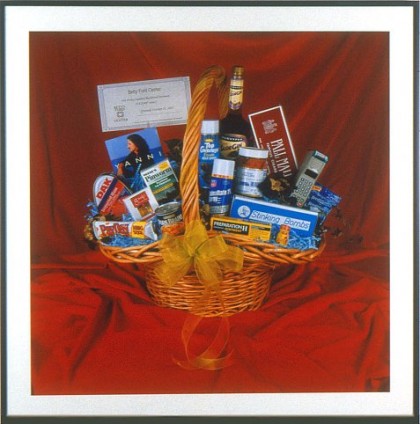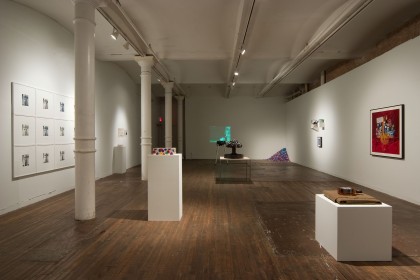On the P.S. 1 Spring Openings and the Post-Alanna Era
P.S. 1 Contemporary Art Center
Lutz Bacher, My Secret Life
Jonathan Horowitz, And/Or
Kenneth Anger
February 22 - September 14, 2009
I might eventually write something more extensive on P.S. 1, but a first impression of the three shows that opened on Sunday, February 22 - Lutz Bacher, Jonathan Horowitz, and Kenneth Anger - was that it felt like a rather thin and tepid affair, the issue-oriented credentials and vaunted cultural semiotic concerns of the various artists notwithstanding.

Bacher's main gallery, which the press release defines as "the installation's frenetic epicenter", contains her alterna-captioned news photos, reformulating world leaders as kibbitzers (JFK with Barry Goldwater: "So you want this fucking job?") or focusing on the utter strangeness of Jane Fonda during her anti-Vietnam War days.
Bacher also appropriates, to tasty effect that both critiques and rewards the "male gaze", some Vargas girl pinups taken from Playboy Magazine. It is a heady send-up of America's heedless cultural hegemony and shameless vulgarity during the 1960s, particularly trenchant in light of our current moment of uncertainty.
But while there were other pithy cultural meditations on view - I particularly enjoyed the Jackie and Me series of low resolution b/w photos, purporting to document paparazzo Ron Galella chasing Jacqueline Kennedy through Central Park - the show suffered from terminal enervation in several of its peripheral rooms.
Admittedly, this enervation is often purposeful, and results from found imagery intentionally chosen to reveal its graphic degradation - through "signal disturbances, tracking problems, stoppages, burnouts and other artifacts of a corrupted or damaged videotape" - as per the text for Olympiad (1997). But I wonder whether a fashionably pessimistic, slacker aesthetic of precious graininess and graphic interference, a fetishization of media's inherent entropy (the seeds of its own destruction - hello Karl Marx!) is enough to carry our interest throughout the various rooms.

Horowitz can also be a hit-or-miss proposition. His Ben Hur/Rome mockumentary is an uncertain effort; one is never quite sure on which side of Irony Street he is actually standing. A bit better is his metaphysical conundrum/assemblage film, Silent Movie, which conflates film segments of deaf, dumb and blind protagonists like The Who's Tommy and Patty Duke's Helen Keller, all to the unmanned accompaniment of a player piano.
The political commentary of a publicity photo of Bush, framed and hung upside down (like the Antichrist), or a Vatican portrait of Pope Benedict torn in half is, well, obvious. As is the extended photo excoriation of gay-basher Anita Bryant.
A king-sized bed covered by a white duvet, under the neon sign of a double cross, attempts to locate the bedroom as the true locus of ingrained religious, political and sexual intolerance: sleep locally, act globally.
Tofu on Pedestal in Gallery is hilariously and precisely that; so is the photo of Britney's crotch. And it is easy to embrace the minimal, lockjaw humor of mon.-sun., a video monitor accompanied by seven VHS tapes that continually displays the text of the appropriate day of the week. But some of Horowitz's other gestures are either overly obscure, poorly enunciated, too deadpan, or perhaps just too understated to resonate.

No one would claim that an over-the-top, tabloid sensationalist like Anger suffers from similar understatement. But his eight films (including Invocation of My Demon Brother and Scorpio Rising) are miserably crowded into a single large second floor gallery, and suffer from a murky hodgepodge of vinyl coated floors and walls, alternating soundtracks, cubbyholes, dangling light bulbs, and other spooky ephemera. I'm sure the intention was to create an installation that was moodily dark and goth, a mirror of Anger's own rebel consciousness. Unfortunately it results in physical confusion and total incomprehension.
At this point, with the recent "leader out" forced march of Alanna Heiss, a major question circulating among the art pundit-ocracy is how the institution will fare. As I have pointed out in an earlier posting, Heiss has not been immune to missteps, to mounting obscure art and indulging in woefully failed experimentation. The three Spring 2009 shows are probably part of her continuing legacy, and were undoubtedly prepared under her aegis. So the jury is out on the essential question: Does P.S. 1 still need Alanna?
This text was originally published as a shorter alphanumeric-ism.
Lutz Bacher, My Secret Life
Jonathan Horowitz, And/Or
Kenneth Anger
February 22 - September 14, 2009
I might eventually write something more extensive on P.S. 1, but a first impression of the three shows that opened on Sunday, February 22 - Lutz Bacher, Jonathan Horowitz, and Kenneth Anger - was that it felt like a rather thin and tepid affair, the issue-oriented credentials and vaunted cultural semiotic concerns of the various artists notwithstanding.

Bacher's main gallery, which the press release defines as "the installation's frenetic epicenter", contains her alterna-captioned news photos, reformulating world leaders as kibbitzers (JFK with Barry Goldwater: "So you want this fucking job?") or focusing on the utter strangeness of Jane Fonda during her anti-Vietnam War days.
Bacher also appropriates, to tasty effect that both critiques and rewards the "male gaze", some Vargas girl pinups taken from Playboy Magazine. It is a heady send-up of America's heedless cultural hegemony and shameless vulgarity during the 1960s, particularly trenchant in light of our current moment of uncertainty.
But while there were other pithy cultural meditations on view - I particularly enjoyed the Jackie and Me series of low resolution b/w photos, purporting to document paparazzo Ron Galella chasing Jacqueline Kennedy through Central Park - the show suffered from terminal enervation in several of its peripheral rooms.
Admittedly, this enervation is often purposeful, and results from found imagery intentionally chosen to reveal its graphic degradation - through "signal disturbances, tracking problems, stoppages, burnouts and other artifacts of a corrupted or damaged videotape" - as per the text for Olympiad (1997). But I wonder whether a fashionably pessimistic, slacker aesthetic of precious graininess and graphic interference, a fetishization of media's inherent entropy (the seeds of its own destruction - hello Karl Marx!) is enough to carry our interest throughout the various rooms.

Horowitz can also be a hit-or-miss proposition. His Ben Hur/Rome mockumentary is an uncertain effort; one is never quite sure on which side of Irony Street he is actually standing. A bit better is his metaphysical conundrum/assemblage film, Silent Movie, which conflates film segments of deaf, dumb and blind protagonists like The Who's Tommy and Patty Duke's Helen Keller, all to the unmanned accompaniment of a player piano.
The political commentary of a publicity photo of Bush, framed and hung upside down (like the Antichrist), or a Vatican portrait of Pope Benedict torn in half is, well, obvious. As is the extended photo excoriation of gay-basher Anita Bryant.
A king-sized bed covered by a white duvet, under the neon sign of a double cross, attempts to locate the bedroom as the true locus of ingrained religious, political and sexual intolerance: sleep locally, act globally.
Tofu on Pedestal in Gallery is hilariously and precisely that; so is the photo of Britney's crotch. And it is easy to embrace the minimal, lockjaw humor of mon.-sun., a video monitor accompanied by seven VHS tapes that continually displays the text of the appropriate day of the week. But some of Horowitz's other gestures are either overly obscure, poorly enunciated, too deadpan, or perhaps just too understated to resonate.

No one would claim that an over-the-top, tabloid sensationalist like Anger suffers from similar understatement. But his eight films (including Invocation of My Demon Brother and Scorpio Rising) are miserably crowded into a single large second floor gallery, and suffer from a murky hodgepodge of vinyl coated floors and walls, alternating soundtracks, cubbyholes, dangling light bulbs, and other spooky ephemera. I'm sure the intention was to create an installation that was moodily dark and goth, a mirror of Anger's own rebel consciousness. Unfortunately it results in physical confusion and total incomprehension.
At this point, with the recent "leader out" forced march of Alanna Heiss, a major question circulating among the art pundit-ocracy is how the institution will fare. As I have pointed out in an earlier posting, Heiss has not been immune to missteps, to mounting obscure art and indulging in woefully failed experimentation. The three Spring 2009 shows are probably part of her continuing legacy, and were undoubtedly prepared under her aegis. So the jury is out on the essential question: Does P.S. 1 still need Alanna?
This text was originally published as a shorter alphanumeric-ism.






